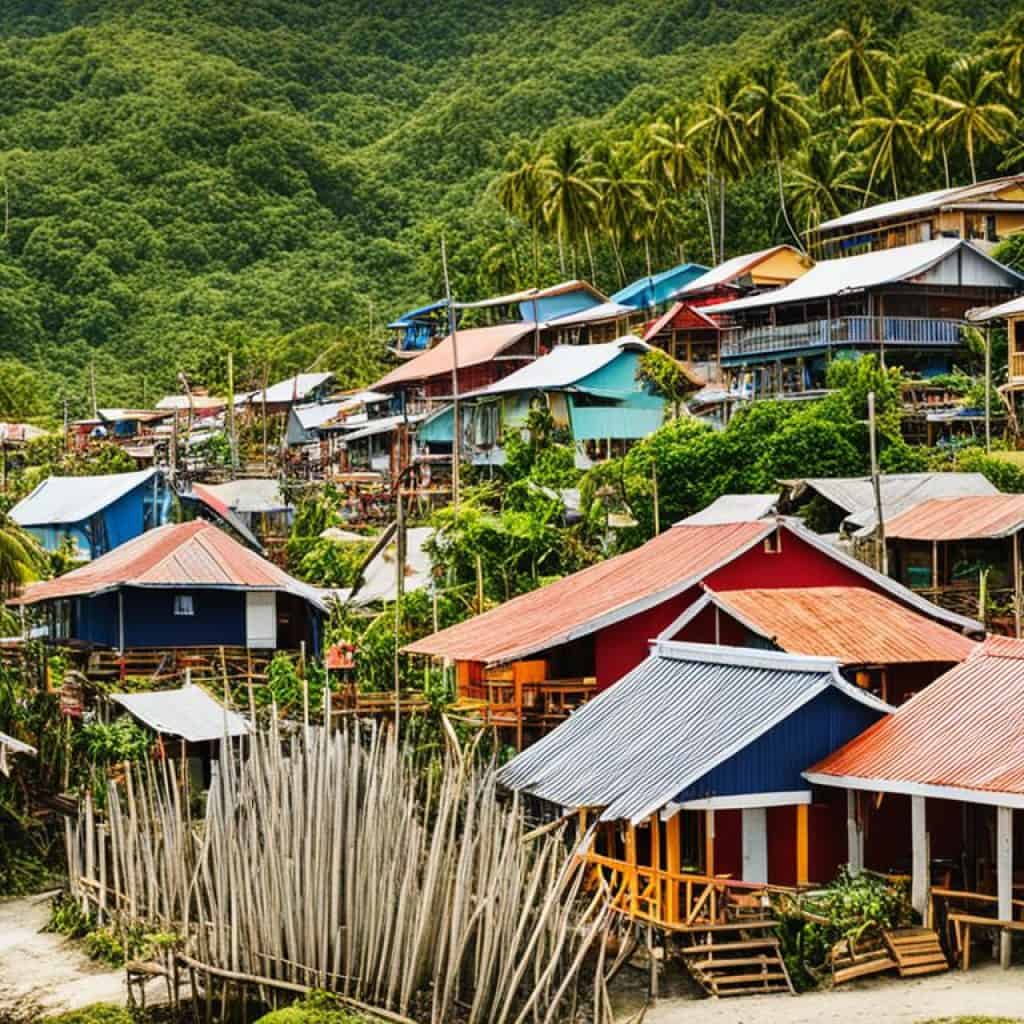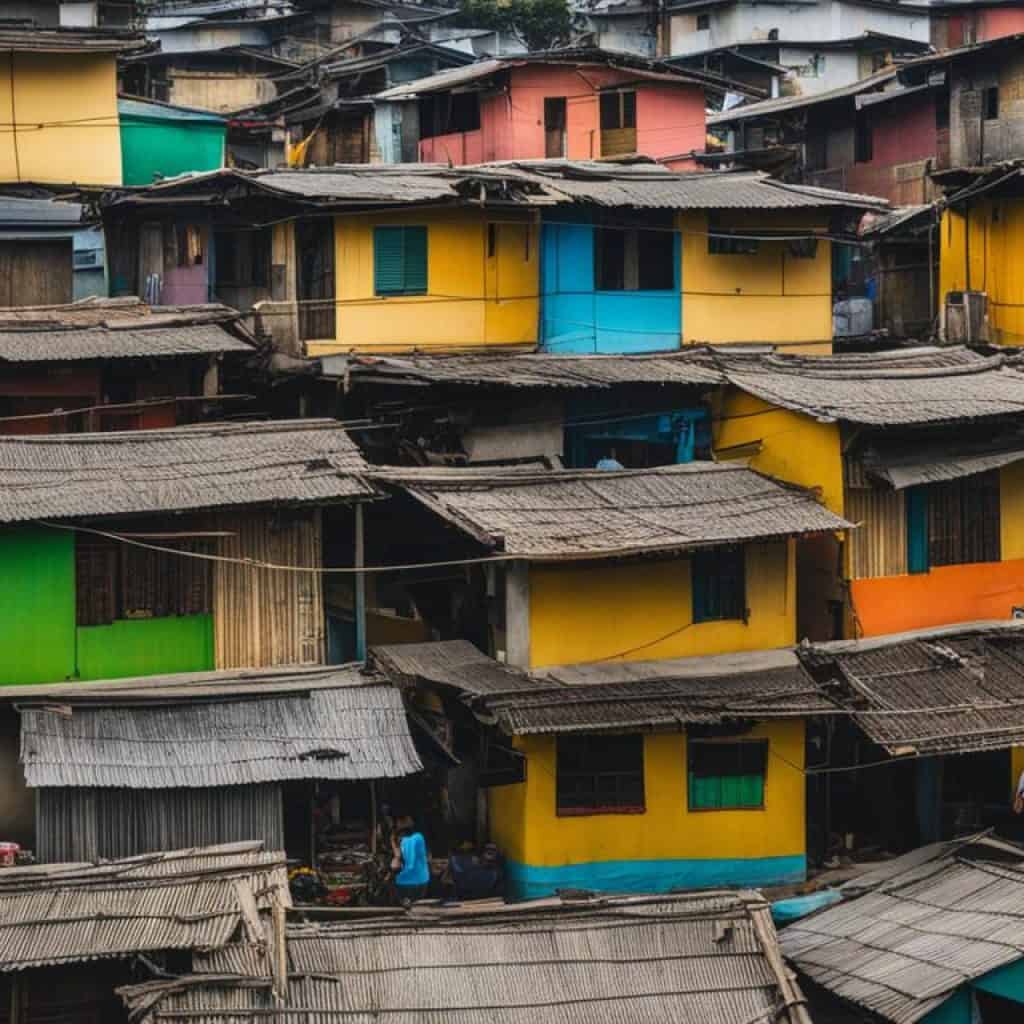Have you ever wondered how many Americans have made the Philippines their home? Are you curious about the American expat community in the Philippines and their experiences living there? You may be surprised to discover the size and influence of the American population in the Philippines. Read on to find out more about this fascinating community and the reasons why Americans choose to migrate to this Southeast Asian nation.
Key Takeaways:
- The estimated number of Americans living in the Philippines is around 35,000.
- The Philippines is home to a diverse American expat community with varying reasons for choosing to live in the country.
- Americans migrate to the Philippines for family issues, business purposes, the pursuit of a better life, and the desire for residency or citizenship in another country.
- Other popular destinations for American expats include Mexico, Canada, the United Kingdom, Germany, and Australia.
- Living in the Philippines as an American involves considering factors such as visa requirements, housing options, healthcare, and banking practices.
Reasons Americans Become Expats
Americans choose to become expatriates for a variety of reasons. These include family issues, business purposes, a desire for a better life, or the pursuit of residency or citizenship in another country. The decision to leave the United States and live abroad is highly individual and influenced by a combination of factors.
Some Americans become expats due to family issues such as caring for sick relatives who reside overseas. This may involve the need to provide support and be closer to their loved ones during challenging times.
For others, becoming an expat is driven by business purposes. It could involve the opportunity to start a new venture, explore international markets, or take up a job offer in a different country. Expanding their horizons and seeking new career prospects abroad can be a compelling reason for Americans to become expats.
The pursuit of a better life is another motivating factor. Some individuals choose to live abroad to enjoy a higher standard of living, access affordable healthcare, or experience a different cultural environment. This may involve relocating to a country with better social welfare programs, a stronger economy, or a safer living environment.
Moreover, many Americans aspire to obtain residency or citizenship in another country. This could be driven by a desire for a change in lifestyle, political or economic stability, or broader opportunities for personal and professional growth.
“Becoming an expat is a transformative experience that opens up new horizons and provides opportunities for personal growth. It allows individuals to immerse themselves in different cultures, broaden their perspectives, and embrace exciting adventures.”
Ultimately, the decision to become an expat is deeply personal and unique to each individual. Some Americans may be driven to explore new frontiers, pursue their dreams, or simply seek a different way of life. By venturing beyond their home country, these expatriates embark on a journey of self-discovery and embrace the myriad opportunities that the world has to offer.
Where Are People Going?
Americans looking to become expatriates have a wide range of destinations to choose from around the world. These countries offer attractive opportunities for American expats, including affordable cost of living, quality healthcare, diverse cultural attractions, and friendly populations. Some popular destinations for American expats include:
- Mexico
- Canada
- United Kingdom
- Germany
- Australia
- Israel
- South Korea
- France
- Japan
- Italy
- Spain
- Philippines
- New Zealand
These countries offer a diverse range of opportunities and experiences for American expats. Whether it’s the bustling streets of Tokyo, the stunning beaches of Australia, or the rich history of European cities, there is something for everyone. Each destination has its unique charm and attractions that cater to different preferences and lifestyles.
Countries With The Most American Expats
When it comes to American expats, some countries are more popular than others. Let’s take a look at the countries with the highest number of American expatriates:
| Country | Number of American Expats | Percentage of Americans Abroad |
|---|---|---|
| Mexico | 800,000 | 28% |
| Canada | 280,000 | 10% |
| United Kingdom | 200,000 | 8% |
| Germany | 150,000 | 5% |
| Australia | 120,000 | 4.2% |
| Israel | 80,000 | 2.8% |
| South Korea | 68,000 | 2.5% |
| France | 60,000 | 2.2% |
| Japan | 57,000 | 2% |
| Italy | 55,000 | 2% |
| Spain | 48,000 | 1.8% |
| Philippines | 35,000 | 1.3% |
| New Zealand | 20,000 | 0.8% |
As you can see, Mexico tops the list with a population of 800,000 American expats, comprising 28% of Americans living abroad. Canada follows closely behind with 280,000 American expats, accounting for 10% of Americans abroad. The United Kingdom, Germany, and Australia also have significant American expat communities, with numbers ranging from 200,000 to 120,000.
These countries offer a range of opportunities and attractions for American expats, including affordable cost of living, quality healthcare, cultural experiences, and employment prospects. Whether it’s retiring in Mexico, exploring career opportunities in Germany, or enjoying the laid-back lifestyle in Australia, there are plenty of options for Americans seeking a new life abroad.
American Settlement in the Philippines
American settlement in the Philippines traces its roots back to the colonial period when the United States gained control of the archipelago from Spain in 1898. This marked the beginning of a significant chapter in the history of American settlement in the region.
The American colonialization of the Philippines led to a surge in immigration, attracting retiring soldiers and military personnel seeking new opportunities. The Philippines became a destination for Americans looking to start a new life in a foreign land.
At the same time, American teachers were recruited to establish an English-language education system in the Philippines. This initiative has left a lasting impact on the country’s education landscape, shaping the development of English proficiency among Filipinos.
âThe American colonization period was a turning point in the history of the Philippines, with significant contributions to various aspects of society and culture.â
The American presence in the Philippines also brought about advancements in sanitation. The Americans implemented measures to improve public health and hygiene, impacting the overall well-being of the Filipino population.
Moreover, the presence of Amerasians, children of Filipino parents and American service members, has contributed to the American-descendant population in the Philippines. Their unique heritage and experiences have added to the cultural diversity of the country.
American Settlement in the Philippines - Key Contributions
| Aspects of American Settlement | Key Contributions |
|---|---|
| American Immigration During Spanish Colonial Rule | Increased immigration among retiring soldiers and military personnel |
| American Education System in the Philippines | Recruitment of American teachers to establish an English-language education system |
| American Influence on Philippine Sanitation | Implementation of measures to improve public health and hygiene |
| American Impact on Philippine Independence | Significant role in shaping the Philippines’ path towards independence |
| Amerasians in the Philippines | Contributed to the American-descendant population and cultural diversity |
The American settlement in the Philippines has left a lasting legacy, touching various aspects of society and culture. From immigration and education to sanitation and independence, the American influence continues to shape the Philippines as a nation.

Can a US citizen live in the Philippines?
Yes, a US citizen can live in the Philippines for a long-term stay. The Philippines offers various visa options for US citizens based on their specific purposes, whether it’s for work, study, retirement, starting a business, or joining family or a spouse in the country. Each visa type has its own requirements, and it is important to obtain the appropriate visa based on the individual’s circumstances.
In some cases, residency permits may also be required for specific purposes such as work or retirement. US citizens who wish to reside in the Philippines should ensure they meet all the necessary requirements and obtain the proper documentation to legally stay in the country for an extended period.
The Philippines welcomes expatriates from around the world and offers a range of opportunities for US citizens who want to live and settle in the country.
Whether you are seeking employment, pursuing higher education, reuniting with family members, or looking for a peaceful retirement destination, the Philippines has options to suit your needs. It is advisable to consult the Embassy of the Philippines or official immigration authorities to obtain accurate and up-to-date information about visa requirements and the necessary procedures for long-term stay in the country.
Immigration and Visas
Here are some of the visa types available for US citizens:
- Work Visa in the Philippines: If you wish to work in the Philippines, you will need to obtain a work visa. This requires documentation such as proof of identity, employment details, and a valid job offer from a Philippine company.
- Student Visa in the Philippines: For US citizens planning to study in the Philippines, a student visa is required. This visa category may require acceptance letters from educational institutions and proof of financial capability.
- Retirement Visa in the Philippines: If you are looking to retire in the Philippines, you can apply for a retirement visa. This visa requires proof of a pension or retirement income and meeting certain age requirements.
- Spouse Visa in the Philippines: US citizens who are married to a Philippine citizen can apply for a spouse visa. This visa category requires proof of marriage and documentation to establish the validity of the relationship.
- Quote Visa in the Philippines: Certain situations may allow for entry under a special quota. This could include individuals with exceptional skills or qualifications that benefit the Philippines.
Living in the Philippines: The Basics
Living in the Philippines offers a unique experience with its vibrant culture, beautiful landscapes, and affordable lifestyle. In this section, we will explore the basics of living in the country, including the cost of living, housing options, healthcare system, banking, education, and transportation.
Cost of Living in the Philippines
The cost of living in the Philippines is generally lower compared to the US, making it an attractive destination for many expatriates. Everyday expenses, such as meals, groceries, utilities, and rent, are significantly cheaper. Affordable housing options are available, particularly outside major cities, allowing individuals to live comfortably within their budget.
Housing in the Philippines
When it comes to housing in the Philippines, there are various options to consider. Expatriates can choose to rent or buy property based on their preferences and needs. Renting is popular among expats due to its flexibility and the opportunity to explore the local real estate market before making a long-term commitment. The cost of housing in the Philippines is generally more affordable compared to the US, opening up possibilities for property ownership for many.
Healthcare in the Philippines
The healthcare system in the Philippines comprises both public and private healthcare facilities. While the public healthcare system has limitations in terms of resources and quality, private healthcare is recommended for expatriates. It provides access to higher quality services and facilities. It is important for US citizens living in the Philippines to secure health insurance to cover medical expenses and ensure peace of mind.
Banking in the Philippines
US citizens can easily open bank accounts in the Philippines, allowing them to manage their finances conveniently. Major banks offer a wide range of services and facilities, including online banking and ATM access. It is recommended to visit a branch to open a bank account and verify your identity. Understanding local banking practices and regulations is vital for hassle-free transactions and financial management.
Education in the Philippines
The education system in the Philippines follows an American model, making it easier for US citizens to adapt and enroll their children in schools. English is widely spoken, which facilitates communication for expatriates. There are various international schools that offer education based on international curricula, providing a smooth transition for expat children.
Transportation in the Philippines
The transportation infrastructure in the Philippines is well-developed, offering various options for getting around. Public transport, such as buses, jeepneys, and tricycles, is widely available and affordable. Taxis and ride-hailing services are also popular in urban areas. Domestic flights are convenient for travel between islands, allowing individuals to explore the beautiful destinations that the Philippines has to offer.
Living in the Philippines can be an exciting and enriching experience. By understanding the basics of living in the country, expatriates can navigate their new environment with ease and make the most of their time in this beautiful nation.
Cost of Living in the Philippines
The cost of living in the Philippines is significantly lower compared to the US, making it an attractive destination for US citizens looking for a more affordable lifestyle. Everyday expenses such as meals, groceries, utilities, and rent are generally cheaper, allowing individuals to stretch their budget and enjoy a comfortable life in the Philippines.
Here is a breakdown of the average prices for everyday items in the Philippines:
- Rent: Rent in the Philippines is more affordable, especially outside major cities like Manila. Whether you choose to live in a condo, apartment, or house, you can find options that fit your budget.
- Utilities: The cost of utilities, including electricity, water, and internet, is relatively low in the Philippines compared to the US. This means you can enjoy the comforts of a fully connected home without breaking the bank.
- Food: Eating out and grocery shopping in the Philippines is generally cheaper. Local markets offer fresh produce at affordable prices, and you can savor delicious meals at local eateries without spending a fortune.
This table provides a cost comparison between the Philippines and the US for some everyday expenses:
| Expense | Philippines | US |
|---|---|---|
| Rent (1-bedroom apartment, city center) | $200 – $400 | $1,000 – $2,000 |
| Meal at a local restaurant | $3 – $5 | $10 – $20 |
| Grocery shopping (monthly) | $100 – $200 | $300 – $500 |
| Utilities (monthly) | $50 – $100 | $100 – $200 |
As you can see, the cost of living in the Philippines is considerably lower than in the US. This allows US citizens to enjoy a comfortable lifestyle while maintaining a lower budget. With the money saved, you can explore the beautiful beaches, indulge in local culture, and create unforgettable experiences in the Philippines.

Cost of Moving to the Philippines
Moving to the Philippines is an exciting endeavor, but it’s important to consider the costs involved in the transportation and relocation process. Here are some key factors to keep in mind:
Shipping Costs to the Philippines
Shipping costs for furniture and belongings can vary depending on the size of your shipment and the distance between the origin and destination. It’s advisable to obtain quotes from several shipping companies to compare prices and services. Additionally, consider any customs duties or import taxes that may apply when shipping your items to the Philippines.
Flights to the Philippines
If you’re moving from the US to the Philippines, it’s important to factor in the cost of flights. Prices can vary depending on the time of year, airline, and booking class. It’s recommended to book your flights in advance to secure the best rates. Don’t forget to consider the number of family members or pets traveling with you, as additional tickets or fees may be required.
Bringing Pets to the Philippines
If you plan to bring your pets with you when moving to the Philippines, there may be additional expenses involved. Every country has its own rules and regulations regarding pet importation, so it’s crucial to research the requirements of the Philippines. Some key considerations may include pet vaccinations, health certificates, and quarantine periods. Be sure to budget for these expenses and make the necessary arrangements well in advance of your move.
In conclusion, moving to the Philippines requires careful planning and budgeting. Take into account the shipping costs, flights, and any additional expenses related to bringing pets. By considering these factors, you can have a smoother and less stressful transition to your new home in the Philippines.
Housing in the Philippines
Renting in the Philippines: Renting is a popular choice among expatriates, as it provides flexibility and the opportunity to explore the local real estate market before making a long-term commitment. From apartments to houses, there are various rental properties available throughout the country.
Buying Property in the Philippines: If you prefer to own a property, the Philippines offers a more accessible real estate market compared to the US. The cost of housing in the Philippines is generally lower, allowing for more affordable property ownership than in many other countries.
The real estate market in the Philippines is diverse, catering to different budgets and preferences. Whether you are looking for a modern condominium in the heart of the city or a beachfront villa, there are options available to suit every lifestyle.
When searching for housing in the Philippines, it is advisable to work with a reputable real estate agent or communicate with online platforms specialized in the local market. This will help you navigate the process more efficiently and ensure you find the right property that meets your specific requirements.

Renting vs. Buying: Which is Right for You?
Deciding between renting and buying property in the Philippines depends on your personal circumstances and long-term plans. Renting offers flexibility, allowing you to easily relocate or explore different areas of the country. On the other hand, buying property provides the security and stability of homeownership and the potential for property appreciation over time.
“Renting offers flexibility, while buying property provides the security and stability of homeownership.”
Consider factors such as your financial situation, duration of stay, and your long-term goals when making this decision. Renting may be more suitable for those who are unsure about their long-term plans in the Philippines or prefer not to tie up their finances in real estate. On the other hand, buying property can be a good investment for those who plan to stay in the country for an extended period or have a clear vision of their future in the Philippines.
The Cost of Housing in the Philippines
The cost of housing in the Philippines is generally lower compared to the US, making it an attractive option for expatriates. Rent prices vary depending on the location and the type of property. In major cities like Manila, renting an apartment in the city center is generally more expensive than in suburban areas.
| Housing Expense | Average Cost |
|---|---|
| Rent for a One-Bedroom Apartment (City Center) | $250-$600 |
| Rent for a One-Bedroom Apartment (Outside of City Center) | $125-$400 |
| Price per Square Meter to Buy an Apartment in the City Center | $850-$1,700 |
| Price per Square Meter to Buy an Apartment Outside of City Center | $500-$1,200 |
Note: These prices are approximate and may vary depending on the location, property type, and other factors.
The cost of utilities such as electricity, water, and internet services is relatively affordable in the Philippines. However, it’s important to budget for these expenses when planning your housing costs.
Healthcare in the Philippines
The healthcare system in the Philippines comprises both public and private healthcare facilities. While the public healthcare system may have limited resources, the private sector offers higher quality services and facilities that are recommended, especially for expatriates.
Public Healthcare in the Philippines:
The public healthcare system in the Philippines faces challenges due to limited resources and funding. It is ranked relatively low in terms of global healthcare standards. However, public hospitals and clinics still serve a significant portion of the population, especially in rural areas where access to private healthcare may be limited.
Private Healthcare in the Philippines:
The private healthcare sector in the Philippines offers a wide range of providers, including hospitals, clinics, and specialist centers. Private healthcare facilities often have modern infrastructure, state-of-the-art equipment, and highly skilled medical professionals. Many private hospitals in major cities are internationally accredited and cater to the needs of expatriates and foreign visitors.
Health Insurance in the Philippines:
Health insurance is crucial for individuals living in the Philippines. It not only provides financial protection in case of medical emergencies but also ensures access to quality healthcare services. Expatriates are advised to secure health insurance that covers medical expenses, hospitalization, and other healthcare services in order to receive the best possible care.
Banking and Taxation
When moving to the Philippines as a US citizen, it’s essential to understand the banking and taxation system in the country. Opening a bank account in the Philippines is a straightforward process that typically requires a visit to a branch for identity verification. This allows you to access banking services and manage your finances with ease.
In major cities, ATMs are widely available, providing convenient access to cash. However, it’s important to note that some ATMs may charge fees for withdrawals. To avoid unnecessary charges, it is advisable to choose ATMs affiliated with your bank or those that offer free cash withdrawals.
One crucial aspect to consider when living in the Philippines is understanding the local banking practices and tax regulations. As a US citizen, you may be subject to taxation in both the US and the Philippines. It’s vital to consult with tax professionals to ensure compliance with the tax obligations in both countries.
Taxes in the Philippines are imposed on residents and non-residents based on their income and other factors. Depending on your circumstances, you may need to file taxes in both the US and the Philippines, or take advantage of tax treaties and credits to avoid double taxation.
Consulting with tax professionals who specialize in US-foreign taxation can help you navigate the complexities of tax obligations and ensure that you meet all the necessary requirements. They can provide guidance on issues such as tax residency, reporting foreign assets, and claiming foreign tax credits.
By having a clear understanding of the banking and taxation systems in the Philippines, you can effectively manage your finances and fulfill your tax obligations, ensuring a smooth and trouble-free experience as an American expat living in this beautiful country.
Conclusion
Living in the Philippines as an American offers a unique and rewarding experience. With its affordable cost of living, diverse culture, and breathtaking natural beauty, the Philippines has become a popular choice for American expatriates. The country boasts a growing American community of approximately 35,000 individuals, making it easy to find a sense of belonging and connection.
When considering a move to the Philippines, it is essential to carefully plan and navigate the various factors that come into play. Understanding the visa requirements, exploring housing options, researching healthcare facilities, and familiarizing oneself with the banking system are crucial steps in ensuring a successful transition.
Overall, with thorough preparation and a positive mindset, Americans can make the most out of their life in the Philippines. Embrace the vibrant Filipino culture, soak in the breathtaking landscapes, and create lasting memories in this tropical paradise. Living in the Philippines as an American opens up endless possibilities for adventure, personal growth, and a more fulfilling lifestyle.
FAQ
How many Americans live in the Philippines?
There are approximately 35,000 Americans living in the Philippines, accounting for 1.3% of the population of Americans living abroad.
Why do Americans become expats?
Americans become expats for various reasons, such as family issues, business purposes, or the pursuit of a better life.
Where are Americans going as expats?
Americans are going to various countries as expats, including popular destinations such as Mexico, Canada, the United Kingdom, Germany, Australia, Israel, South Korea, France, Japan, Italy, Spain, the Philippines, and New Zealand.
Which countries have the most American expats?
The countries with the most American expats include Mexico, Canada, the United Kingdom, Germany, Australia, Israel, South Korea, France, Japan, Italy, Spain, the Philippines, and New Zealand.
What is the history of American settlement in the Philippines?
American settlement in the Philippines dates back to the colonial period when the United States acquired the archipelago from Spain in 1898. American immigration increased during the American colonialization of the Philippines.
Can a US citizen live in the Philippines?
Yes, a US citizen can live in the Philippines for a long-term stay. Different visa types are available for various purposes, such as work, study, retirement, or joining family or a spouse in the country.
What are the immigration and visa requirements for US citizens in the Philippines?
What should I know about living in the Philippines?
Living in the Philippines involves understanding various aspects, including the cost of living, housing options, healthcare system, banking, education, and transportation.
How does the cost of living in the Philippines compare to the US?
The cost of living in the Philippines is generally lower compared to the US, with affordable housing options, lower everyday expenses, and more affordable rent, utilities, and food costs.
What are the costs associated with moving to the Philippines?
Moving to the Philippines entails considering the costs associated with transportation and relocation, including shipping costs, flights, and potentially bringing pets to the country.
What are the housing options in the Philippines?
Housing options in the Philippines include renting and buying property, with renting being popular among expatriates due to flexibility and affordability.
What is the healthcare system like in the Philippines?
The healthcare system in the Philippines consists of public and private healthcare facilities. Private healthcare is recommended for expatriates, and it is advisable to secure health insurance for access to quality healthcare.
Can US citizens open bank accounts in the Philippines?
Yes, US citizens can open bank accounts in the Philippines, although visiting a branch for identity verification may be required. It’s important to understand local banking practices and tax regulations.
Is it worth living in the Philippines as an American?
Moving to the Philippines as an American offers opportunities for a more affordable lifestyle, diverse cultural experiences, and access to beautiful beaches and natural landscapes.


















Add comment